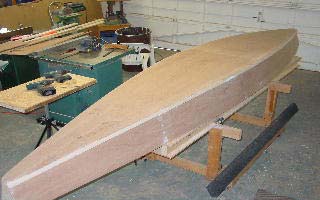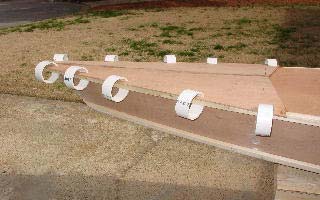Piragua
by Joe
Wiseman
I don't recall exactly when
I started building Jim Michalak's Piragua,
but building time was approx 20 hours, not counting drying time.
I am pretty slow, and made several patterns during the process
in case I wanted to make another boat.

Sides and chine rails in place

Bottom glued and trimmed with router
I used the typical Luan 1/4
inch ply, and the highly touted PL Premium glue for most of the
construction. I did make my scarfs and floor joints from West
epoxy since it is a known quantity, and the PL is new to me. I
was impressed with the PL's holding power and price, but did not
like the bubbling that occurs during curing. If you like smoothly
fared joints, it generates much added work. If one is not that
particular, or it is used in hidden areas, it would seem a good
choice. I'm a bit fussy so I will probably stick to epoxy next
time.

Clamping outwales

Taping seams with epoxy
For chines and gunnels, I
scarfed 1X3X8 furring strips together then ripped them length
wise on the table saw. This gave me two 16 foot pieces for each
pair of furring strips. If you pick through the stacks, you can
usually find fairly clear straight stock, in my case, for $1.80
each, from Lowes home center.

Foredeck clamped in place
The only deviations from
the plans I made were to put a peak in the fore deck, both for
strength and eye appeal, and to use a inwale and outwale, rather
than two outwales as per plans. The latter was for purely cosmetic
reasons. I felt Jim knew best how to build his boat, so I otherwise
stuck to his specs.

Checking position for seat and foot
rest

Seat and mast step installed
Paint was exterior latex
over latex primer, also from Lowes. This was a first for me. What
a treat to work with latex rather than boat paint. We will see
over the long run if I am happy with it.

Ready to go
My after thoughts are: the
boat is a bit heavy (around 60-70 pounds I would guess) the result
of overly heavy chines and rails and 3/4 stock for back up plates
for joining the plywood. This seems to me as over kill. I used
a piece of 1/4 plywood on the inside and two strips of epoxy/cloth
on the outside of my floor seam, which I guess is another deviation
from the plans. I have total confidence in this type of joint.
Jim seems very conservative about such matters, and I can understand
that. His plans were excellent and the best value in the industry,
as many others have attested.

Marilyn trying out the Piragua
I have ordered plans for
Jim's "Twixt"
which I hope to build soon. Next, is a traditional Chesapeake
Bay fishing skiff from lines taken from an old time builder in
Reedville, Virginia on the Eastern Shore of Chesapeake Bay. Other
than using a plywood bottom rather than cross planking and a bit
of epoxy here and there, it will be made from the traditional
Juniper wood with traditional lines. I will keep you posted.
Joe Wiseman
VA. Beach,
Virginia |

